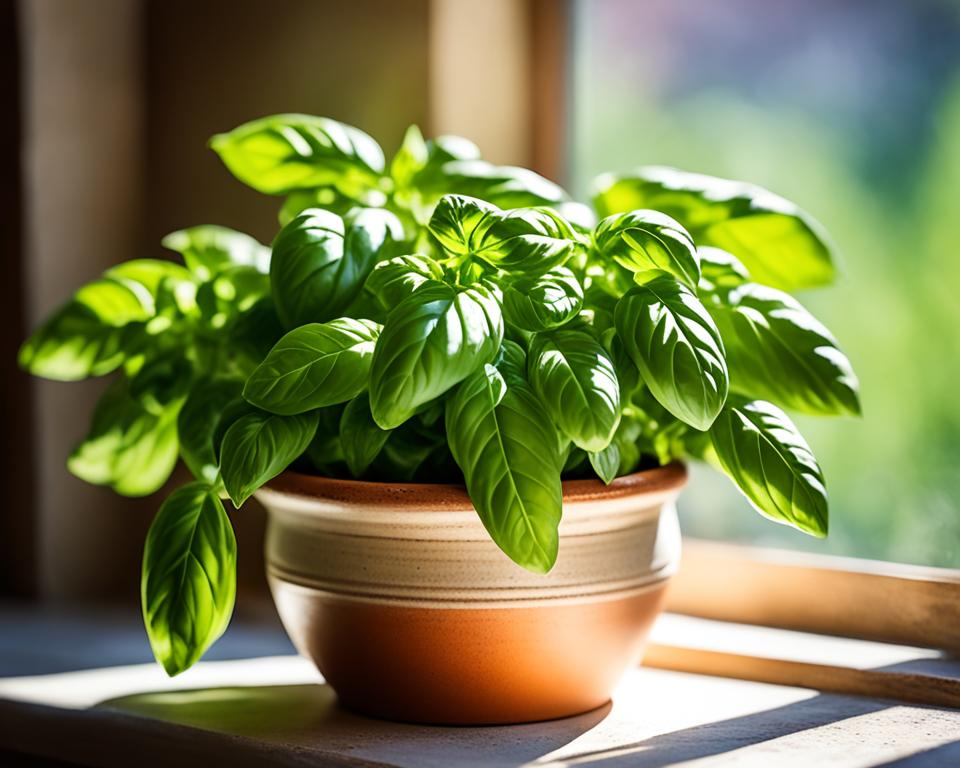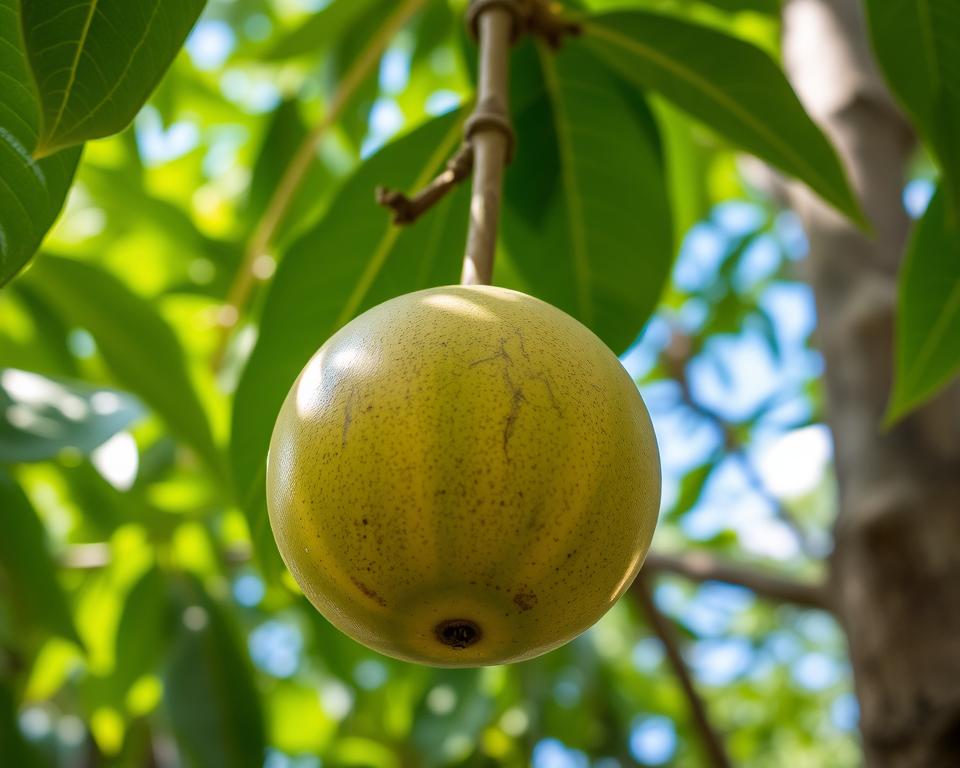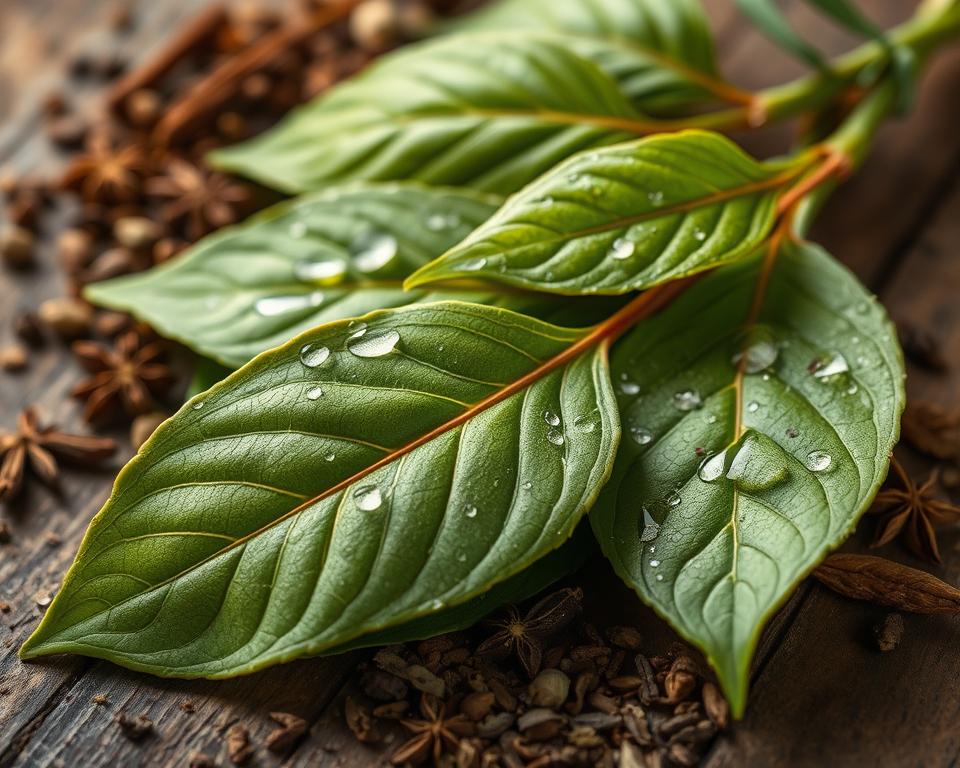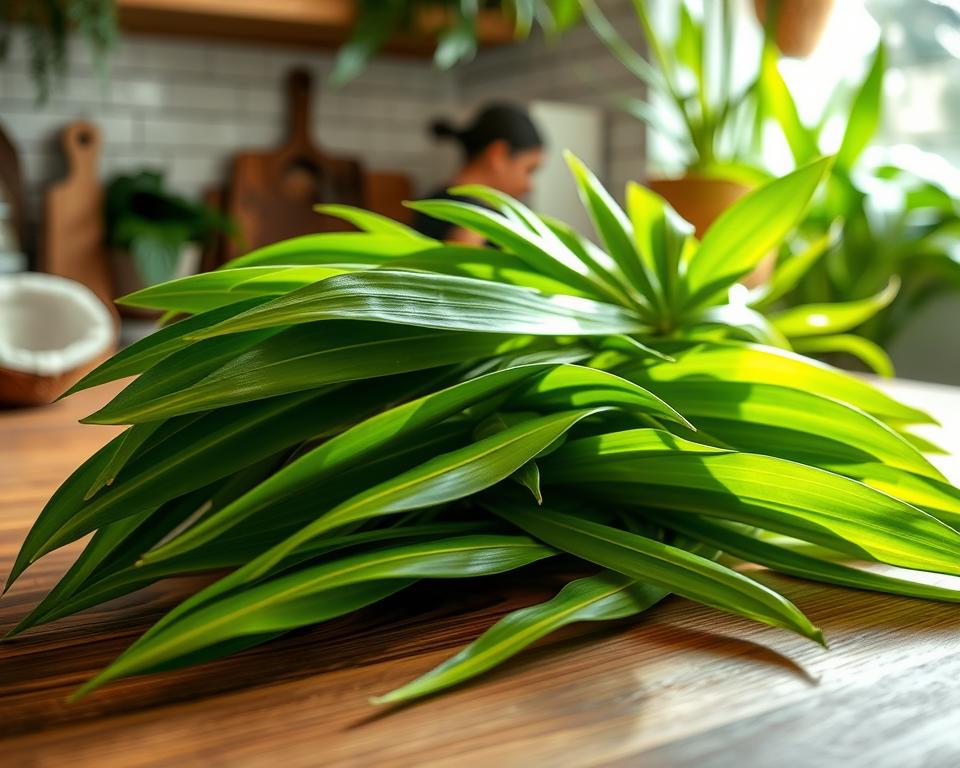Welcome to our guide on Italian basil! Whether you’re a fan of Italian cuisine or simply enjoy the aromatic flavors of culinary herbs, Italian basil is a must-have in any herb garden. In this article, we will delve into the cultivation tips for Italian basil and explore its various uses in the kitchen.
Italian basil, also known as Ocimum basilicum, is a popular herb with a distinct flavor and aroma. Its vibrant green leaves and delightful scent make it a staple in Italian dishes such as pasta sauces, pizzas, and salads. But Italian basil isn’t limited to Italian cuisine alone; it can be creatively used in a wide range of international dishes to add depth and freshness.
Growing and caring for Italian basil is relatively easy, making it an excellent choice for both seasoned gardeners and beginners. You can cultivate it in your backyard herb garden or even indoors if you don’t have access to outdoor space. With the right techniques, you’ll have a bountiful harvest of organic Italian basil to elevate your culinary creations.
In the following sections, we’ll explore Italian basil varieties, essential tips for growing and caring for your basil plants, step-by-step planting guides, and techniques for preserving the herb. We’ll also discuss the role of Italian basil in Italian cuisine, provide classic recipes to try, and highlight its medicinal properties. Whether you’re looking to expand your herb garden or explore new flavors in the kitchen, Italian basil has something to offer.
Read interesting things at : tosawakan
Key Takeaways:
- Italian basil is a versatile herb with a distinct flavor and aroma, perfect for Italian cuisine and other international dishes.
- Growing and caring for Italian basil is relatively easy, making it suitable for gardeners of all levels.
- Italian basil varieties include Genovese basil, Italian Large Leaf basil, and Purple Ruffles basil.
- Utilize Italian basil in classic Italian recipes like pesto sauce and Caprese salad, as well as in creative ways in different cuisines.
- Italian basil offers not only culinary benefits but also medicinal properties and the joy of growing your own herb garden.
Understanding Italian Basil Varieties
Italian basil is renowned for its distinct flavor and aroma, making it a favorite herb in many culinary dishes. While there are several varieties of basil available, understanding the different Italian basil varieties can help you choose the perfect one for your herb garden.
Here are some popular Italian basil varieties:
- Genovese basil: This variety of Italian basil is known for its sweet and spicy flavors. It is commonly used in pesto sauce, Caprese salad, and other traditional Italian dishes.
- Italian Large Leaf basil: As the name suggests, this basil variety features large, glossy leaves. It has a slightly milder flavor compared to Genovese basil and is often used in soups, stews, and sauces.
- Purple Ruffles basil: This visually striking variety has beautiful purple foliage and a sweet taste. Purple Ruffles basil adds a unique touch to salads, desserts, and garnishes.
Each Italian basil variety has its own unique characteristics, so feel free to experiment with different types to discover your personal favorites.
The Versatility of Italian Basil
Italian basil can elevate the flavors of various cuisines, not just limited to Italian dishes. Its aromatic presence complements a wide range of culinary herbs and spices, enhancing the overall taste profile of your creations.
Italian basil’s versatility allows it to shine in recipes spanning different global cuisines. Whether it’s a Thai curry, Greek salad, or Mexican salsa, this herb adds a delightful freshness and complexity to dishes.
Understanding the nuances of Italian basil varieties empowers you to make informed choices when planning your herb garden and creating delectable meals. Let’s move on to the next section and explore essential tips for successfully growing Italian basil.
Growing Italian Basil: Essential Tips
To successfully grow Italian basil, it is important to provide the right conditions and care. By following these essential tips, you can ensure a thriving herb garden and enjoy a bountiful supply of organic basil.
Choosing the Right Location
Italian basil thrives in warm, sunny locations. Choose a spot in your herb garden that receives at least 6-8 hours of direct sunlight per day. This will help the plants develop strong stems and flavorful leaves.
Additionally, ensure that the location has well-draining soil to prevent waterlogging, which can lead to root rot.
Preparing the Soil
Before planting Italian basil, prepare the soil by loosening it and removing any weeds or debris. Add organic matter such as compost or well-rotted manure to enrich the soil and improve its fertility.
Ensure the soil has a pH level between 6.0 and 7.5, as this is the optimal range for basil growth.
Watering and Fertilizing
Italian basil requires regular watering to keep the soil evenly moist. Water the plants thoroughly, making sure to avoid overwatering or allowing the soil to dry out completely.
Fertilize your basil plants every 4-6 weeks with a balanced organic fertilizer. This will provide them with the necessary nutrients for healthy growth and robust flavor.
Organic Pest Control and Companion Planting
To protect your Italian basil from pests without the use of harmful chemicals, employ organic pest control methods. This can include using insecticidal soaps, companion planting with natural pest repellents like marigolds or garlic, or creating physical barriers such as row covers.
Companion planting basil with other herbs like parsley or thyme can also help deter pests and improve overall plant health.
Essential Tips for Growing Italian Basil
| Tip | Description |
|---|---|
| Choose the Right Location | Select a sunny spot with well-draining soil. |
| Prepare the Soil | Loosen the soil and enrich it with organic matter. |
| Watering and Fertilizing | Water regularly and fertilize every 4-6 weeks with organic fertilizer. |
| Organic Pest Control | Use natural methods to repel pests and companion planting to deter them. |
By implementing these essential tips, you can ensure the successful growth of Italian basil in your herb garden. With proper care, you’ll have a continuous supply of flavorful organic basil to enhance your culinary creations.
Planting Italian Basil: Step-by-Step Guide
Planting Italian basil is an exciting endeavor that allows you to enjoy the fresh flavor and aroma of this versatile herb. Whether you’re starting from seeds or transplanting seedlings, proper planting techniques are essential for the healthy development of your basil plants. Follow this step-by-step guide to ensure success in growing basil in your herb garden.
1. Choosing the Right Location
Before planting Italian basil, select a sunny location that receives at least 6-8 hours of direct sunlight daily. Basil thrives in warm temperatures, so choose a spot that provides the ideal growing conditions.
2. Preparing the Soil
Italian basil prefers well-draining soil with a pH level between 6.0 and 7.5. Prepare the soil by removing any weeds or debris and loosening it with a garden fork or tiller. Incorporate organic matter such as compost or well-rotted manure to improve the soil’s fertility and drainage.
3. Sowing Seeds or Transplanting Seedlings
If starting from seeds, sow them directly into the prepared soil, following the packet instructions for spacing and depth. Alternatively, if you’re transplanting seedlings, dig a hole slightly larger than the root ball and gently place the seedling into it, ensuring the top of the root ball is level with the soil surface.
4. Proper Spacing
Proper spacing is crucial for optimal growth and airflow around your basil plants. Space the seedlings or seeds according to the recommended guidelines provided on the seed packet, usually between 8-12 inches apart.
5. Providing Support (Optional)
While Italian basil doesn’t generally require support, taller varieties like Genovese basil may benefit from being staked or caged to prevent bending or breaking under the weight of their leaves. Use bamboo stakes or small cages for support, ensuring they are inserted into the ground without damaging the roots.
6. Watering and Mulching
After planting, water your basil thoroughly to settle the soil and promote root establishment. Keep the soil consistently moist but not saturated throughout the growing season. Applying a layer of organic mulch around the plants helps retain moisture, suppresses weeds, and moderates soil temperature.
7. Regular Care
Basil plants require regular care to ensure healthy growth and abundant foliage. Monitor the moisture levels in the soil and water when the top inch feels dry. Avoid overhead watering, as wet foliage can lead to diseases. Additionally, pinch off any flower buds that appear to promote bushier growth and prevent premature flowering.
8. Enjoying Your Basil Harvest
As your Italian basil plants grow, you can start harvesting the leaves once they reach a mature size. To harvest, simply snip off the top leaves, leaving the lower leaves intact. Regular harvesting promotes new growth and helps keep your basil plants productive throughout the season.
By following this step-by-step guide, you’ll be well on your way to growing healthy and flavorful Italian basil in your herb garden. Remember to provide the right growing conditions, space your plants properly, and care for them diligently. With proper planting techniques and care, you can enjoy a bountiful harvest of fresh basil for all your culinary adventures.
Nurturing Italian Basil: Watering and Fertilizing
Proper watering and fertilizing are essential aspects of caring for Italian basil plants to ensure healthy growth and abundant foliage. In this section, we’ll guide you through the specifics of watering and fertilizing your basil plants, allowing you to nurture them effectively.
Watering Italian Basil
Italian basil plants require consistent moisture to thrive, but overwatering can lead to root rot and other issues. The key is to provide adequate hydration while allowing the soil to dry slightly between waterings. Here are some watering tips:
- Water your basil plants deeply, ensuring that the soil is moist at least 1 to 2 inches below the surface.
- Water early in the day to allow the foliage to dry before evening, reducing the risk of disease.
- Use a watering can or gentle spray to avoid damaging the delicate leaves and stems.
- Monitor the moisture levels and adjust the frequency of watering based on weather conditions and the plant’s needs.
- Avoid wetting the leaves excessively, as this can contribute to fungal diseases.
By following these watering guidelines, you can maintain the proper moisture balance for your Italian basil plants, ensuring their optimal growth.
Fertilizing Italian Basil
Italian basil plants can benefit from regular fertilization to provide them with essential nutrients. Here are some tips for fertilizing your basil:
- Start by preparing the soil with organic matter such as compost or well-rotted manure before planting.
- Apply a balanced organic fertilizer, such as a 10-10-10 or 5-5-5 formulation, once every 4 to 6 weeks during the growing season.
- Avoid overfertilizing, as this can lead to excessive leaf growth and reduced flavor.
- Follow the instructions on the fertilizer packaging for the recommended application rates and methods.
- Consider using a liquid fertilizer diluted with water for easy absorption and nutrient uptake.
Remember to water your basil plants before applying fertilizer to prevent root burn. Maintaining a consistent fertilization schedule will ensure that your Italian basil receives the necessary nutrients for robust growth and flavorful leaves.
| Common Mistakes | Best Practices for Watering and Fertilizing Italian Basil |
|---|---|
| Overwatering, leading to root rot and leaf diseases. | Water deeply but allow the soil to dry slightly between waterings. |
| Inconsistent watering, causing stressed plants and uneven growth. | Monitor moisture levels and maintain a regular watering schedule. |
| Underfertilizing, resulting in pale leaves and stunted growth. | Apply a balanced organic fertilizer every 4 to 6 weeks during the growing season. |
| Overfertilizing, leading to excessive leaf growth and reduced flavor. | Follow the recommended application rates and avoid overfertilization. |
By understanding the specific watering and fertilizing needs of Italian basil plants, you can provide them with optimal care, leading to healthy, flavorful herbs that elevate your culinary creations.
Pruning and Harvesting Italian Basil
Proper pruning and harvesting are essential aspects of basil plant care that contribute to the overall health and productivity of your Italian basil plants. Pruning not only promotes bushier growth but also prevents premature flowering, allowing you to enjoy fresh basil leaves for a longer period. In this section, we will discuss the correct techniques for pruning and how to harvest your Italian basil for optimal flavor and longevity.
Pruning Techniques for Italian Basil
Regular pruning of Italian basil plants encourages the growth of lush foliage and prevents the plants from becoming leggy or overgrown. Follow these pruning techniques to ensure the health and vibrancy of your basil plants:
- Start pruning when the basil plants have developed around 6 to 8 sets of leaves.
- Use clean and sharp gardening shears or scissors to make clean cuts just above a leaf node or set of leaves.
- Always prune the basil plants above the node or set of leaves, leaving a small portion of stem attached to encourage new growth.
- Remove any discolored or damaged leaves during the pruning process.
- Prune the basil plants regularly, especially when you notice the flowers forming, to prevent energy from being diverted to seed production.
Pruning your Italian basil plants not only shapes their growth but also enhances their flavor and aroma. By keeping the plants well-maintained and preventing flowering, you can enjoy an abundance of fresh basil leaves throughout the growing season.
Harvesting Italian Basil
Knowing when and how to properly harvest your Italian basil is crucial for maintaining a continuous supply of fresh, aromatic leaves. Follow these steps to harvest your basil plants:
- Begin harvesting when the basil plants have reached a height of about 6 to 8 inches.
- Select healthy, mature leaves from the top of the plant, leaving the small, developing leaves at the base intact to promote new growth.
- Use clean gardening shears or scissors to make clean cuts just above a leaf node or set of leaves.
- Harvest the basil leaves in the morning when the essential oils are at their peak, ensuring the best flavor and aroma.
- Regularly harvest the mature leaves to encourage continuous growth and prevent the plants from flowering prematurely.
Harvesting Italian basil at the right time and using proper techniques ensures that you’ll have a fresh supply of flavorful leaves for your culinary endeavors. It also stimulates the plants to produce new growth, allowing for a bountiful harvest throughout the growing season.
| Pruning Benefits | Harvesting Benefits |
|---|---|
| Promotes bushier growth | Maintains a continuous supply of fresh basil leaves |
| Prevents premature flowering | Enhances flavor and aroma |
| Ensures healthier and more productive plants | Stimulates new growth |
By following the proper pruning and harvesting techniques for your Italian basil, you can enjoy an abundance of fresh, flavorful leaves that will elevate your culinary creations. Pruning promotes healthy growth, while harvesting at the right time ensures optimal taste and aroma. Remember to regularly prune and harvest your basil plants to maximize their productivity and enjoy the benefits of this aromatic herb.
Cooking with Italian Basil: Classic Italian Recipes
Italian cuisine is renowned for its bold flavors and vibrant ingredients, and one of the key players in creating these delicious dishes is Italian basil. This aromatic herb adds a burst of freshness and complexity to a wide range of recipes, making it a must-have ingredient in any Italian kitchen.
Whether you’re a seasoned chef or an aspiring home cook, incorporating Italian basil into your cooking can elevate your dishes to new heights. Let’s explore some classic Italian recipes that showcase the delightful flavors of this versatile herb:
Pesto Sauce
Pesto sauce is a beloved Italian condiment that highlights the flavors of Italian basil in all its glory. Made with fresh basil leaves, pine nuts, garlic, Parmesan cheese, and olive oil, pesto sauce is incredibly versatile. Toss it with pasta, spread it on crusty bread, or use it as a marinade for grilled meats and vegetables—it’s sure to impress your taste buds.
Caprese Salad
A true celebration of Italian flavors, Caprese salad is a simple yet elegant dish that showcases the combination of Italian basil, ripe tomatoes, and fresh mozzarella cheese. Drizzled with olive oil, balsamic glaze, and sprinkled with salt and pepper, this salad is a refreshing and satisfying appetizer or side dish.
“The secret to a perfect Caprese salad lies in using the freshest ingredients, allowing the flavors of the Italian basil to shine through.”
Tomato and Mozzarella Pizza
Italian basil is a key ingredient in the classic Margherita pizza, which features ripe tomatoes, mozzarella cheese, and a generous sprinkle of this aromatic herb. The combination of the sweet tomatoes, creamy cheese, and the bold herby flavor of the basil creates a pizza that is the epitome of Italian perfection.
-
- Table: Top Classic Italian Recipes with Italian Basil
| Recipe | Description |
|---|---|
| Pesto Sauce | A versatile sauce made with fresh Italian basil, pine nuts, garlic, Parmesan cheese, and olive oil. Perfect for tossing with pasta or spreading on crusty bread. |
| Caprese Salad | A refreshing salad made with ripe tomatoes, fresh mozzarella cheese, Italian basil, and drizzled with olive oil and balsamic glaze. |
| Tomato and Mozzarella Pizza | A classic pizza topped with fresh tomatoes, mozzarella cheese, and Italian basil. The epitome of Italian perfection. |
These are just a few examples of how Italian basil can transform ordinary dishes into culinary masterpieces. Its vibrant flavor and aroma add depth and authenticity to Italian cuisine. So, next time you’re cooking up an Italian feast, don’t forget to grab some fresh Italian basil—the essence of true Italian flavors.
Beyond Italian Cuisine: Creative Uses for Italian Basil
Italian basil is a versatile culinary herb that can elevate dishes from various cuisines. Its aromatic flavor and distinct aroma make it a popular choice for enhancing the taste of both traditional and international recipes. In this section, we’ll explore some creative ways to incorporate Italian basil into your cooking repertoire while highlighting its compatibility with other culinary herbs.
Italian basil’s fresh and vibrant flavor pairs well with a wide range of ingredients, allowing you to experiment with different flavor combinations. Whether you’re preparing Asian-inspired stir-fries, Mexican salsas, or Mediterranean salads, Italian basil can add a refreshing taste to your dishes.
Complementing Other Culinary Herbs
Italian basil’s versatility extends to its ability to complement other culinary herbs, enhancing the overall flavor profile of your dishes. When combined with complementary herbs like parsley, thyme, or rosemary, Italian basil can create a harmonious blend of aromas that tantalize the taste buds.
Italian basil’s aromatic notes can harmonize with the freshness of parsley, the earthiness of thyme, or the piney scent of rosemary, creating a symphony of flavors in your culinary creations.
Italian Basil Infused Oils and Vinegars
Another way to make the most of Italian basil’s flavors is by infusing its aromatic essence into oils and vinegars. By steeping fresh basil leaves in high-quality olive oil or vinegar, you can create infused oils and vinegars that can be used as dressings, marinades, or finishing touches for your dishes.
Italian basil-infused oils and vinegars can add depth and complexity to various recipes, be it tossed in salads, drizzled over roasted vegetables, or used as a flavoring agent for sauces and marinades.
Refreshing Basil Beverages
Italian basil is not limited to savory dishes; it can also be used to create refreshing and unique beverages. From fruity basil-infused lemonades to herbaceous basil cocktails, the possibilities are endless.
Indulge in the refreshing combination of Italian basil and citrus flavors by infusing fresh basil leaves into lemonades or creating basil-infused simple syrups for cocktails.
Exploring Fusion Cuisine
If you really want to get creative, Italian basil can be used in fusion cuisine, blending traditional recipes with international flavors. Incorporate Italian basil into dishes like Thai-inspired basil fried rice or Italian-Mexican fusion tacos for an exciting and delicious twist.
Italian basil’s versatility knows no bounds when it comes to experimenting with different cuisines, allowing you to infuse traditional recipes with unique flavors and create new culinary experiences.
Creative Uses for Italian Basil
| Italian Basil Application | Description |
|---|---|
| Infused Oils and Vinegars | Steep fresh Italian basil leaves in high-quality olive oil or vinegar for flavorful dressings, marinades, and finishing touches. |
| Refreshing Basil Beverages | Create unique and refreshing drinks by infusing Italian basil into lemonades or using it as a garnish for herbaceous cocktails. |
| Fusion Cuisine | Add Italian basil to fusion dishes, combining traditional recipes with international flavors for a culinary adventure. |
When it comes to cooking with basil, the possibilities are endless. By thinking outside the box and incorporating Italian basil into a variety of cuisines, you can add depth and complexity to your culinary creations while exploring the herb’s versatility. Let your creativity flourish and enjoy the delightful flavors that Italian basil brings to your table.
Preserving Italian Basil: Drying and Freezing Techniques
To enjoy the flavor of Italian basil all year round, it’s important to know how to preserve it. Whether you have an abundant harvest or want to extend the lifespan of store-bought basil, drying and freezing are effective methods for preserving this aromatic herb.
Drying Italian Basil
Drying Italian basil is a straightforward method that concentrates the flavors and preserves the herb’s aroma. Follow these steps to dry your basil:
- Harvest your basil in the morning when the essential oils are at their peak.
- Gently wash the basil leaves and pat them dry.
- Remove the leaves from the stems and discard any damaged or discolored ones.
- Spread the basil leaves in a single layer on a clean, dry surface.
- Place the basil in a well-ventilated area away from direct sunlight.
- Allow the leaves to dry naturally for approximately 1-2 weeks, or until they become crispy and crumble easily.
- Once dried, store the basil in an airtight container or resealable plastic bag.
Your dried basil can be used in various culinary creations, such as marinades, soups, and sauces. Remember to crush the leaves right before use to release their full flavor.
Freezing Italian Basil
Freezing Italian basil is another excellent option for preserving its vibrant taste and vibrant green color. Follow these steps to freeze your basil:
- Wash the basil leaves and separate them from the stems.
- Blanch the basil leaves in boiling water for a few seconds, then immediately transfer them to an ice bath to stop the cooking process.
- Pat the leaves dry with a clean kitchen towel or paper towel.
- Place the basil leaves in a single layer on a baking sheet lined with parchment paper.
- Flash freeze the basil in the freezer for 1-2 hours or until the leaves are solid.
- Transfer the frozen basil leaves into a freezer-safe bag or airtight container.
Frozen basil can be added directly to soups, stews, and sauces while cooking. Alternatively, you can also thaw the basil leaves in the refrigerator before using them as a garnish for salads or pasta dishes.
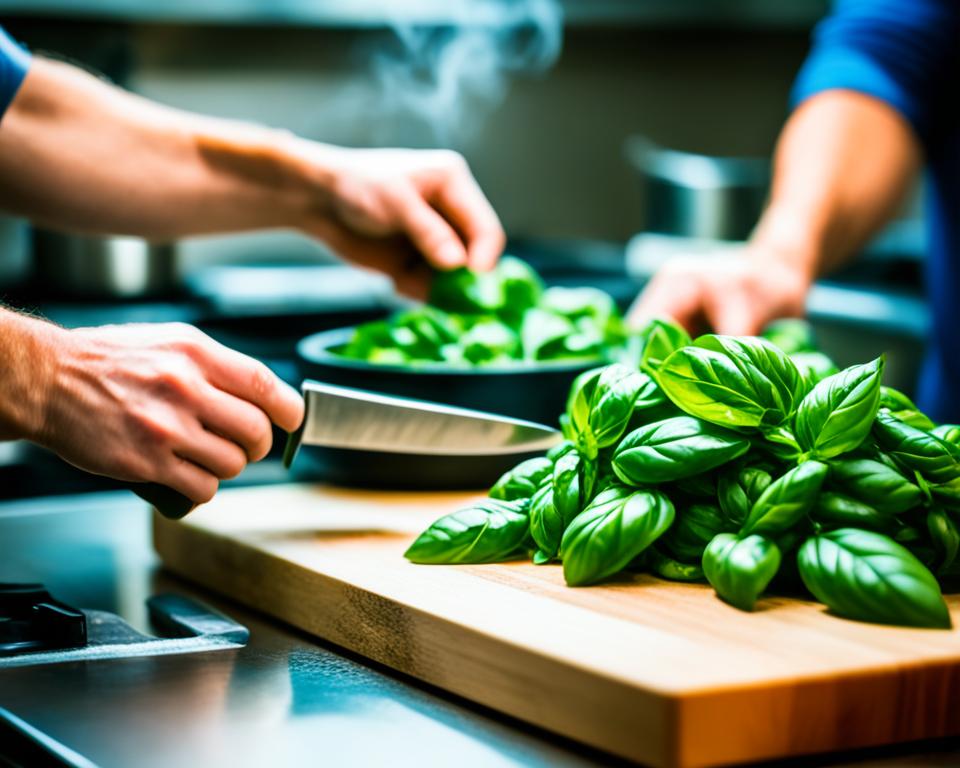
Preserving Italian basil through drying or freezing allows you to savor the herb’s distinctive flavors and aromas long after the growing season has ended. Remember to label your preserved basil with the date of preservation to ensure freshness. Whether you choose to create a jar of dried basil or a bag of frozen leaves, you’ll have the perfect ingredient to enhance your dishes with the essence of fresh Italian basil.
Italian Basil as a Medicinal Herb
In addition to its culinary uses, Italian basil has been treasured for centuries for its medicinal properties. This versatile herb is known to offer a range of health benefits, making it a valuable addition to your herbal remedies and natural wellness practices.
Health Benefits of Italian Basil
Italian basil is rich in antioxidants, vitamins, and essential oils, which contribute to its healing properties. Here are some of the key health benefits associated with this remarkable herb:
- Boosts Immune System: Italian basil contains compounds that can enhance the immune system, helping to protect against common illnesses and infections.
- Relieves Digestive Discomfort: The natural oils present in Italian basil can aid digestion and alleviate digestive issues such as bloating and indigestion.
- Reduces Inflammation: Italian basil possesses anti-inflammatory properties that can help reduce inflammation in the body, potentially relieving symptoms of conditions like arthritis.
- Promotes Respiratory Health: The essential oils found in Italian basil have been shown to have expectorant properties, which can help relieve respiratory congestion and promote clearer breathing.
- Supports Mental Well-being: Italian basil is known to have calming and mood-enhancing effects, making it a beneficial herb for reducing stress and anxiety.
These are just a few examples of the many health benefits associated with Italian basil. As with any holistic approach to wellness, it is important to consult with a healthcare professional before incorporating herbal remedies into your routine.
Using Italian Basil for Medicinal Purposes
There are various ways to harness the medicinal properties of Italian basil:
- Infused Tea: Steep fresh basil leaves in hot water to create a soothing and aromatic herbal tea. This can aid digestion, promote relaxation, and provide an immune system boost.
- Herbal Tincture: Extract the potent compounds of Italian basil by preparing a herbal tincture. This concentrated extract can be used topically or ingested for targeted health benefits.
- Aromatherapy: Inhaling the aroma of Italian basil essential oil can have mood-enhancing effects and promote respiratory health. Use a diffuser or add a few drops to a warm bath for a relaxing experience.
- Topical Applications: Create homemade balms or salves using Italian basil-infused oils to soothe skin irritations, reduce inflammation, or alleviate muscle discomfort.
When using Italian basil for its medicinal properties, it is important to source high-quality, organic herbs and follow recommended dosages. As with any herbal remedy, it is advisable to consult with a qualified herbalist or healthcare professional for personalized guidance.
Growing Italian Basil Indoors
If you don’t have access to an outdoor garden, don’t worry—you can still successfully grow Italian basil indoors. With a few tips and tricks, you can create a thriving herb garden right in your own home. Here’s how:
1. Choose the Right Containers
When growing basil indoors, it’s important to select the right containers. Choose pots or planters that have drainage holes to prevent waterlogging. Additionally, opt for containers that are at least 6-8 inches deep to allow the basil’s roots to spread.
2. Optimize Lighting Conditions
Italian basil thrives in bright, natural light. Place your basil plants near a sunny window where they can receive at least 6-8 hours of sunlight each day. If you don’t have access to sufficient natural light, you can also use fluorescent grow lights to supplement.
3. Provide Adequate Watering
Proper watering is crucial for the healthy growth of Italian basil. Water the plants when the top inch of the soil feels dry to the touch. Be careful not to overwater as it can lead to root rot. Remember, it’s better to underwater than to overwater your basil plants.
4. Maintain Ideal Temperatures
Italian basil prefers temperatures between 60-75°F (15-24°C). Avoid placing your basil plants near cold drafts or heat sources such as radiators. Consistent temperatures within this range will ensure optimal growth and prevent plant stress.
5. Overcoming Indoor Cultivation Challenges
Indoor cultivation can present some challenges, but they can be overcome with the right approach. Consistently monitor humidity levels as dry indoor air can affect the health of your basil plants. Mist the leaves occasionally or use a humidifier to increase humidity. Additionally, indoor plants may be more susceptible to pests, so regularly inspect the foliage for any signs of infestation and take prompt action if necessary.
6. Harvesting Indoor-Grown Basil
When your indoor basil plants reach a height of about 6 inches, you can start harvesting the leaves. Pinch or cut off the top few inches of each stem, just above a set of healthy leaves. Regular harvesting will promote bushier growth and keep your basil plants productive.
By following these tips, you can successfully grow luscious Italian basil indoors. Whether you have limited space or simply want to enjoy fresh herbs year-round, indoor cultivation allows you to have a thriving herb garden right at your fingertips.
Troubleshooting Common Issues with Italian Basil
Despite your best efforts, basil plants may encounter some common issues such as pests, diseases, or nutrient deficiencies. It’s essential to identify and address these issues promptly to ensure your Italian basil plants thrive and remain healthy. Here are some common problems you may encounter and how to tackle them:
Pests
Pests can wreak havoc on your basil plants, causing damage to the leaves and stunting their growth. The most common pests that affect basil plants include aphids, spider mites, and whiteflies. To combat these pests:
- Regularly inspect your basil plants for any signs of pest infestation, such as discolored or distorted leaves.
- If you spot pests on your plants, you can manually remove them by gently wiping the leaves with a damp cloth or spraying them with a mixture of water and mild soap.
- Consider using natural pest control methods like neem oil or insecticidal soap, which are effective in controlling common basil pests.
Diseases
Basil plants are susceptible to certain diseases, including fungal infections like powdery mildew and downy mildew. To prevent and address these diseases:
- Ensure proper air circulation around your basil plants by providing adequate spacing between them.
- Avoid overhead watering, as excess moisture on the leaves can promote the growth of fungal pathogens. Instead, water the plants at their base.
- If you notice signs of disease, such as white powdery patches on the leaves or yellowing, remove the affected leaves immediately to prevent the spread of infection.
- Use a fungicidal spray labeled for use on basil plants to control fungal diseases if the problem persists.
Nutrient Deficiencies
Healthy basil plants require a balanced supply of nutrients. Nutrient deficiencies can manifest as yellowing leaves, stunted growth, or poor flavor. Here’s how you can address nutrient deficiencies:
| Nutrient | Signs of Deficiency | Remedial Actions |
|---|---|---|
| Nitrogen (N) | Pale yellow leaves | Apply a balanced organic fertilizer or an organic nitrogen source according to package instructions. |
| Phosphorus (P) | Purple or dark-colored leaves | Add bone meal or rock phosphate to the soil to increase phosphorus levels. |
| Potassium (K) | Brown or scorched leaf edges | Apply a potassium-rich fertilizer or add potassium sulfate to the soil. |
Regularly monitor your plants for signs of nutrient deficiencies and adjust your fertilization regime accordingly. Remember to follow the recommended application rates to avoid over-fertilization, which can harm your basil plants.
By addressing these common issues promptly and providing proper care, you can ensure that your Italian basil plants grow strong, healthy, and provide you with an abundant harvest of aromatic leaves.
The Benefits of Growing Italian Basil
Growing Italian basil offers numerous benefits beyond its culinary and medicinal uses. Whether you have a dedicated herb garden or a small space on your windowsill, cultivating Italian basil can bring joy and a touch of freshness to your life. Let’s explore some of the advantages of growing this aromatic herb.
1. Fresh Herbs for Cooking
One of the primary benefits of growing Italian basil is having access to fresh herbs right at your fingertips. Imagine stepping outside, plucking a few basil leaves, and adding them to your homemade pasta sauce or Caprese salad. The vibrant flavors and aroma of freshly picked basil can elevate your culinary creations to a whole new level.
2. Aesthetically Pleasing Herb Garden
Italian basil is not only a delicious ingredient but also a visually appealing plant. Its lush green leaves and fragrant presence can enhance the aesthetics of any herb garden or indoor space. Whether you choose to plant it alongside other herbs or feature it as a solo star, Italian basil adds a touch of natural beauty to your surroundings.
3. Organic Basil at Your Fingertips
When you grow Italian basil in your own herb garden, you have complete control over its cultivation. You can choose to grow your basil organically, free from synthetic pesticides or herbicides. By opting for organic methods, you not only ensure the healthiness of your basil but also contribute to a sustainable and eco-friendly approach to gardening.
4. Therapeutic Benefits
Engaging in gardening activities, such as growing Italian basil, can offer therapeutic benefits for both the mind and body. Spending time in nature, nurturing plants, and enjoying the sensory experience of gardening can help reduce stress, improve mental well-being, and promote a sense of fulfillment. It’s an opportunity to connect with nature and find solace in the simple act of nurturing life.
5. Versatile Culinary Uses
Italian basil is an incredibly versatile herb in the culinary world. Its distinct flavor pairs well with various ingredients and cuisines, giving you endless culinary possibilities. Whether you’re preparing Italian dishes, experimenting with international flavors, or adding a refreshing twist to your cocktails, Italian basil can be your go-to herb for adding extra depth and complexity to your recipes.
6. Educational Experience
By growing Italian basil, you embark on a journey of learning and discovery. You’ll gain valuable knowledge about plant care, gardening techniques, and the intricate nature of herbs. It’s an opportunity to teach your children or others about the importance of sustainable food practices, the beauty of nature, and the joys of growing your own herbs.
| Benefits of Growing Italian Basil |
|---|
| Access to fresh herbs for cooking |
| Aesthetically pleasing herb garden |
| Organic basil at your fingertips |
| Therapeutic benefits |
| Versatile culinary uses |
| Educational experience |
Exploring Other Basil Varieties
While Italian basil is a popular choice for herb gardens, there are many other exciting basil varieties that you can cultivate to expand your aromatic collection. Each variety has its own unique characteristics and flavors, offering endless possibilities for culinary exploration.
Here are some notable basil varieties worth exploring:
- Sweet Basil: Known for its mild and slightly sweet flavor, sweet basil is a versatile herb that pairs well with a variety of dishes. It is widely used in Mediterranean cuisine and is a staple in pesto recipes.
- Thai Basil: With its distinctive licorice and anise-like flavor, Thai basil adds a bold and aromatic twist to Southeast Asian dishes. It is an essential ingredient in Thai curries, stir-fries, and noodle dishes.
- Lemon Basil: As the name suggests, lemon basil offers a refreshing citrusy aroma that complements both sweet and savory dishes. It is perfect for adding a burst of bright flavor to salads, desserts, and cocktails.
- Cinnamon Basil: Cinnamon basil has a warm and spicy aroma reminiscent of cinnamon. It is often used in herbal teas, fruit salads, and fruit-based desserts for a unique twist.
- Genovese Basil: Similar to Italian basil in terms of flavor, Genovese basil is characterized by its large and fragrant leaves. It is an essential ingredient in traditional pesto sauce and pairs well with tomatoes and fresh mozzarella in Caprese salads.
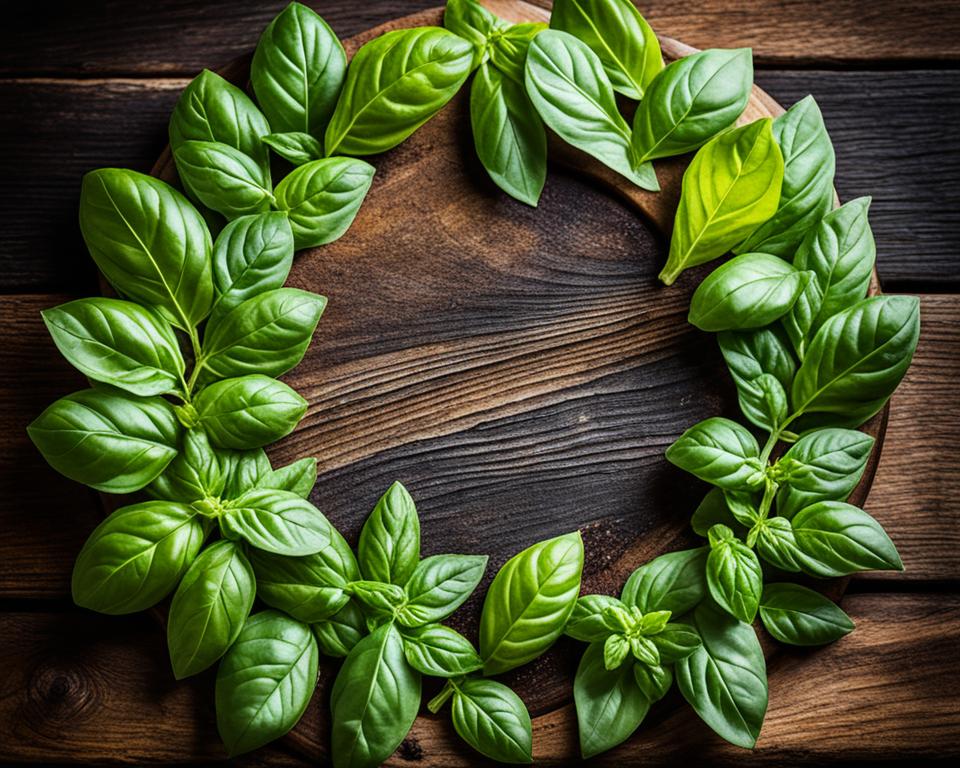
These are just a few examples of the diverse basil varieties available for cultivation. By incorporating different basil varieties into your herb garden, you can elevate your culinary creations and discover new flavors and aromas.
Table: Comparing Basil Varieties
| Basil Variety | Flavor | Uses |
|---|---|---|
| Sweet Basil | Mild and slightly sweet | Pesto, Mediterranean cuisine |
| Thai Basil | Licorice and anise-like | Thai curries, stir-fries, noodles |
| Lemon Basil | Refreshing citrusy | Salads, desserts, cocktails |
| Cinnamon Basil | Warm and spicy | Herbal teas, fruit salads, desserts |
| Genovese Basil | Fragrant and savory | Pesto, Caprese salads |
Conclusion
In conclusion, Italian basil is a versatile and aromatic herb that enhances the flavors of your culinary creations. Whether you choose to grow it in your herb garden or indoors, following the cultivation tips and caring for Italian basil plants can result in a bountiful harvest.
By incorporating Italian basil into your cooking, you can elevate the taste of Italian cuisine and experiment with international dishes. From classic recipes like pesto sauce to innovative combinations with other culinary herbs, the possibilities are endless.
Not only does Italian basil add a delightful touch to your meals, but it also offers medicinal properties with numerous health benefits. Its fresh fragrance and vibrant appearance make it a beautiful addition to your herb garden, complementing other herbs and enhancing the aesthetic appeal.
So why wait? Start growing Italian basil today and enjoy its flavorful and aromatic presence in your everyday life. Bon appétit!






